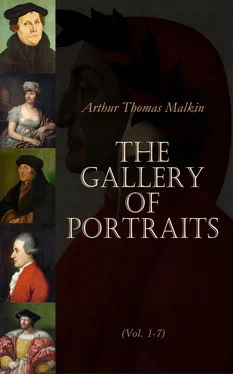From this period the fortune of Poussin began to improve. Relieved from his embarrassments, and tranquillized by domestic comfort, he proceeded in the calm exercise of his powers; and the fine works on which his reputation is founded were painted in rapid succession. Cardinal Barberini, who had returned to Rome, engaged him to execute one of the large paintings ordered to be copied in mosaic for St. Peter’s Church. The subject was the Martyrdom of St. Erasmus; but the picture, which is now in the Vatican, furnishes no reason for regret that Poussin did not more frequently employ himself on works of large dimensions. A circumstance occurred at this time which it is gratifying to relate, as it exhibits two distinguished men engaged in the honourable task of promoting the success and vindicating the reputation of each other. When Poussin arrived at Rome, he found the lovers of art divided into two parties, composed respectively of the admirers of Guido and Domenichino. Two pictures had been painted by those artists, which, as if to decide their rival claims, were hung opposite to each other in the church of San Gregorio. The subjects were similar; the one the Flagellation, the other the Martyrdom of the Saint from whom the church is named. The performance of Guido was the one most generally preferred: but Poussin formed a different judgment, and sat down to copy the picture of the less popular artist. Domenichino, on being informed of this, although he was then suffering from illness, ordered himself to be carried to the church, where he entered into conversation with Poussin, to whom he was personally unknown, and who indeed imagined him to be dead. A friendly intimacy was the consequence of this interview, which was exceedingly advantageous to Poussin, as Domenichino took pleasure in communicating all that knowledge of art, which long experience had enabled him to acquire. Shortly after this Domenichino quitted Rome for Naples, and the storm of envy and detraction seemed to gather force in his absence. So much was his reputation injured, that the monks of the convent of San Girolamo della Carità, who had in their possession his superb picture of the Communion of St. Jerome, ordered it to be removed from the walls and consigned to a cellar as a thing utterly contemptible. This anecdote, were it not attested by unquestionable evidence, would be difficult to believe; for the merits of the picture require no deep knowledge of art to be duly appreciated: it is not less admirable in colour and effect than in sentiment and character. The intelligent monks, however, wishing for a picture to supply its place, engaged Poussin to paint one, acquainting him at the same time that they could save him the expense of canvass, by sending him a worthless daub, over which he might paint. The astonishment of Poussin on receiving the picture may be easily conceived. He immediately directed it to be carried to the church from whence it had been taken, and announced his intention to deliver a public disquisition on its merits. This he accordingly did to a large auditory, and with such force of reasoning and illustration, that malice was silenced and prejudice convinced; and the name of Domenichino assumed from that time its just rank in public estimation.
The pictures of Poussin, as he advanced in his career, were eagerly purchased by connoisseurs from all countries, and his fame was at length established throughout Europe. In 1638 a project was suggested to Louis XIII., by Cardinal Richelieu, for finishing the Louvre, and adorning the royal palaces, according to the magnificent plans of Francis I. The high reputation of Poussin marked him out as the person best qualified for the partial execution and entire superintendence of these splendid works; and accordingly a letter was transmitted to him by order of the French monarch, appointing him his principal painter, and requesting his immediate attendance at Paris. But so absorbed was the artist in his studies, and so unambitious was his temper, that he allowed two years to elapse before he attended to this flattering requisition; nor is it probable that he would have quitted Rome at all, had not a gentleman been despatched from the court of France to bring him. On his arrival, he was presented to the King, who received him with courtesy, and assigned him a liberal income. Placed in the full enjoyment of fame and wealth, Poussin’s situation might well appear enviable to his less favoured brethren in art. But his station, brilliant as it was, proved ill-suited to his disposition: and his letters to his friends in Rome were soon filled with the language of disappointment and complaint. He felt that he was no longer exercising his genius as an artist, but labouring as an artisan. Commissions were poured in upon him from the court with merciless rapidity, without the slightest calculation of the time requisite to the production of works of art. On one occasion he was required to execute a picture containing sixteen figures, larger than life, within six weeks. Nor was this the worst: the triflers of the court obtruded on him, with irritating politeness, the most insignificant employments; designs for chimney-pieces, ornamental cabinets, bindings for books, repairing pictures, &c. To complete the catalogue of annoyances, his coadjutors in the public works, Le Mercier the architect, and the painters Vouet and Fouquieres, thwarted and opposed him in every particular; until at length, worn out and disgusted, he applied for permission to return to Rome. This he obtained with some difficulty, and not without a stipulation that he should revisit Paris within twelve months. It is not improbable that the condition would never have been fulfilled; but the King’s death in the following year released him from the obligation. The last works executed by Poussin in Paris were two allegorical subjects: the one, Time bringing Truth to light, and delivering her from the fiends, Malice and Envy; in which an allusion was most probably meant to the controversies in which he had been engaged: the other, in which his intention is less equivocal, is an imitation of bas-relief, in the ceiling of the Louvre, where his opponents, Fouquieres, Le Mercier, and Vouet, are consigned to the derision of posterity under the figures of Folly, Ignorance, and Envy.
Perhaps the happiest, and not an inconsiderable, portion of Poussin’s life, was that which intervened between his return to Rome and his death. Experience of the cabals and disquietudes of Paris had no doubt taught him to value the classical serenity of his adopted home. Although in possession of great and undisputed fame, and sufficiently affluent, he continued to labour in his art with unrelaxing diligence, if that may be called labour which constituted his highest gratification. His talents and moral worth drew round him a large circle of the learned and the polite, who anxiously sought his society during his leisure hours; and in his evening walks on the Pincian Hill, he might have been said to resemble one of the philosophers of antiquity, surrounded by his friends and disciples. Thus he descended, with tranquil dignity, into the vale of life. In 1665 he suffered from a stroke of the palsy, and, shortly after, the death of his wife plunged him into the deepest affliction. He perceived his own end to be approaching, and awaited it with calm resignation. He died in his 72d year, A. D. 1665, and was buried with public honours in the church of San Lorenzo in Lucina.
The pictures of Poussin are so numerous, and so generally dispersed, that every one, whose attention has been directed to the arts, must have a pretty accurate impression of his style. It is a style of perfect originality, reminding us somewhat of ancient art, but without a tincture of imitation of any modern master. For a short time Poussin sought a model in the school of Titian, but turned from that task to copy the pictures discovered among the ruins of ancient Rome. Apparently he wished to give his works something of the subdued tone which Time has communicated to those relics; and hence, in some of his pictures, there is a singular discrepancy between the subject and the effect. He delighted to paint antique revels, bacchanalians, dancing nymphs, &c.; but his tints never accord with gay subjects, nor exhibit the vivacity and freshness proper to such scenes. The solemn and sombre hue of his colouring is far better adapted to grand or pathetic subjects. Considering the implicit and almost idolatrous admiration with which Poussin regarded the antique statues, it is astonishing that he should not have infused into his own forms more of the spirit in which these are conceived; for, in this point, imitation could not have been carried too far. But the reverse is the case: his figures are direct transcripts of individual models, usually correct in proportion, but seldom rendered ideal, or generalized into beauty. A still greater defect is chargeable on his composition, which is almost invariably scattered and confused, without a centre of interest or point of unity. His principal figures are mixed up with the subordinate ones, and those again with the accessories in the back-ground. What, then, are the qualities by which Poussin has acquired his high reputation? The principal one we conceive to consist in that very simplicity and severity, by which perhaps the eye is at first offended. He appears to feel himself above the necessity of superficial ornament. He is always thoroughly in earnest; his figures perform their business with an emphasis which rivets our attention, we become identified with the subject, and lose all thought of the painter in his performance. This is a result never produced by an inferior artist. On the whole, although we cannot assign Poussin a place by the side of Raffaelle, Rubens, Titian, and some others, who may be considered the giants of art, and compose the foremost rank, he certainly stands among those who are most eminent in the second. His compositions, which are very numerous, are varied with great skill, and surprise us, not unfrequently, with novel and striking combinations; and several among them—we may adduce particularly the Ark of God among the Philistines, the Deluge, and the Slaughter of the Innocents—could only have originated in a mind of a very exalted order.
Читать дальше












